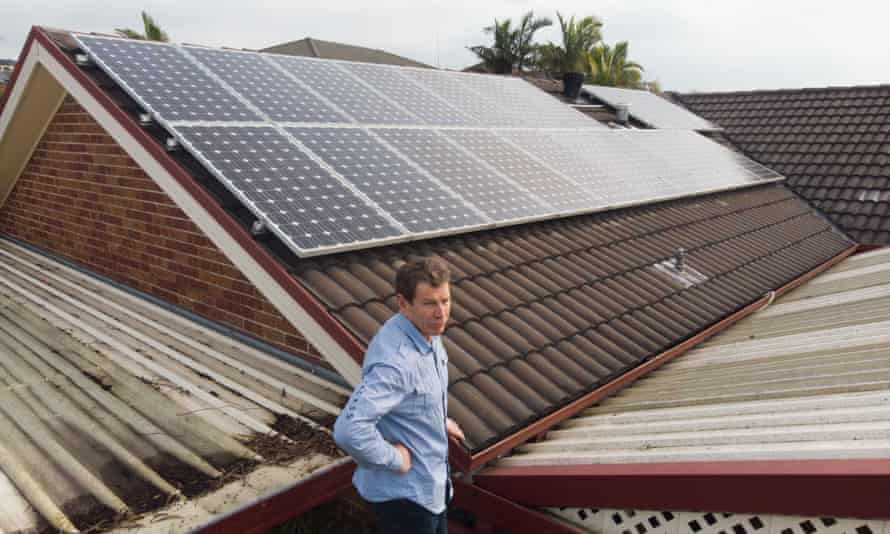Australia’s ‘sun tax’: solar energy supporters split over how to make electricity grid fairer
Rule changes aimed at making room for more household solar systems and batteries on the grid would be unfair to current owners, some say

Michael Streatfeild was an early solar adopter. About a decade ago he withdrew $15,000 from his mortgage to install a 3.6kW system of panels on a north-east facing section of his roof in western Sydney.
Three years ago, in a bid to wipe out his reliance on coal-fired grid electricity, he added a 4kW system and positioned it to catch sun later in the day, when it comes from the north-west.
The sharp fall in the cost of solar in recent years meant the second system, though bigger than the first, cost just $5,000, a third of what he paid in 2011. Together, the two systems have all but wiped out his electricity bills – his last two brought refunds of about $100.
Streatfeild is part of a rapidly expanding Australian story. About 2.8m households have solar systems, with another 3m expected to join them over the next decade. The flood of solar energy those houses create in the middle of the day when the sun is high is rapidly and dramatically transforming the electricity grid.
At peak moments, slightly more than half the electricity across the national market is now from renewable sources, compared with about 30% across the year. In his first speech this week, the new head of the energy market operator, Daniel Westerman, set a target of the entire grid being able to run entirely on renewable energy, at least for brief moments, by 2025.
According to regulators and some analysts, this solar influx, while welcome, is also causing potential problems by creating “traffic jams” in a system that was largely designed to send energy from a few large generators to homes and businesses.
This prompted the Australian Energy Market Commission (AEMC) in March to propose a change that could give network providers the power to charge people who export electricity into the grid at times when it is not needed. It argued the change was necessary to make room for more household solar systems and batteries to be connected to the grid, and to make the system fairer for all users.
The commission, which makes rules for the electricity system, suggested two-way pricing that better rewarded solar and battery owners who send power to the grid at peak times – the early evening, for example. It also recommended new incentives that would give customers more reason to buy batteries or electric vehicles, or set up their homes to consume the power they generate at busy times.
The proposal has proved divisive, pitting against each other those who want to see a rapid expansion of solar but who have different views about what is required to get there.
From Streatfeild’s perspective, the potential new impost is unreasonable, but not surprising. A former police officer and member of the advocacy group Solar Citizens, he says he was motivated to get panels by the climate stance of the then opposition leader Tony Abbott and thoughts about the future his grandchildren faced. “I wanted to be able to say to them, ‘I didn’t fuck this Earth up for you, I did the best I could’,” Streatfeild says.
He believes big electricity generators and networks have a history of profiteering and should bear any transformation costs, while solar consumers should be rewarded for bringing down the wholesale electricity price by undercutting ageing – and increasingly unviable – coal-fired power plants.
“It’s really bad management by the network operators, in my opinion,” Streatfeild says. “They should have foreseen the need for all this. They seem to just want to screw us again.”
Solar Citizens has a similar position. It has labelled the AEMC’s proposal a “sun tax”, and says solar homes and businesses should be rewarded for the benefits they provide, not penalised.
“People have invested in solar in good faith,” says Ellen Roberts, Solar Citizens’ national director. “Any time that people have invested in something and the rules change it is breaching a fairness principle.”
But arguments over fairness and solar power quickly become complicated – the same principle is invoked by supporters of the AEMC proposal.
They say the change is needed in part to ensure a more equitable system for poor households that cannot afford solar panels and therefore bear a greater share of network charges.
Quick GuideHow to get the latest news from Guardian AustraliaShow

Email: sign up for our daily morning briefing newsletter
App: download the free app and never miss the biggest stories, or get our weekend edition for a curated selection of the week’s best stories
Social: follow us on YouTube, Facebook, Instagram, Twitter or TikTok
Podcast: listen to our daily episodes on Apple Podcasts, Spotify or search “Full Story” in your favourite app
The AEMC’s draft rule followed proposals from an unlikely collection of groups, including the power distribution company SA Power Networks and welfare organisations the Australian Council of Social Service (Acoss) and the St Vincent de Paul Society.
Kellie Caught, senior adviser on climate and energy for Acoss, says the country needs a rapid transition to renewable electricity, but the question is who pays for it.
Roughly a third of households are renting, so they can’t install solar panels and rely more heavily on – and pay more for – the poles and wires provided by electricity networks than those with solar.
Caught says people with solar panels did not create the problem regulators are trying to address, but she believes the proposed rule change would benefit both grid security and consumers. “At the moment, the people who can least afford it are carrying more of the network costs,” she says.
She says it is important the change empowers consumers with solar by giving them, and not network operators, the choice over whether they pay to export electricity at busy times or just accept a limit on how much they can send to the grid.
Dylan McConnell, a research fellow at the University of Melbourne Climate and Energy College, also argues cutting emissions must be prioritised, but socially just. He cites research by the Grattan Institute in 2015 that suggests the effective subsidy paid by non-solar households to those with solar would be $3.6bn out to 2030.
McConnell says at the heart of the debate is a question of whether household solar owners have a right to earn revenue by exporting to the grid, given they save money by using their self-generated solar energy at home, and whether that right comes with a responsibility to contribute to the infrastructure changes needed to ensure it is possible.
Bruce Mountain, the director of the Victoria Energy Policy Centre, strongly disagrees. He argues the change proposed by the AEMC is based on a fallacy as the poorest households share the financial benefits of increased solar uptake at a level that far outweighs the additional network costs they face.
He also suggests there is no evidence that more solar in the grid in the middle of the day is a problem that could not be addressed at low cost. “There simply isn’t good evidence of a problem to which export charging is a solution,” Mountain says.
State governments have raised concerns about the change to varying degrees. Both Victoria and Queensland have indicated they do not support export charges. Some states have suggested grandfathering any cost so it does not affect people who already have panels.
Other submissions to the AEMC argue to be effective the change must ensure solar owners who do what it wants – export their electricity when it is most needed – are well rewarded.
They say it needs to become attractive to buy a household battery, or an EV that can both draw and export power to the grid. Neither technology has received the level of government support offered for rooftop panels when they were at similar levels of uptake a decade ago. Coincidentally or otherwise, the AEMC this week released a separate draft plan it says will make it easier for small battery owners to send electricity to the grid and earn revenue.
The commission argues the average solar household with a system of between 4kW and 6kW will still do well after its proposed rule change. It estimates they will save about $900 a year on power bills – about $70 less than currently – and that households without solar would have their bills reduced as they would no longer have to pay for solar export services they do not use.
It says alternatives to introducing an export cost, such as blocking people’s solar exports when the grid is under strain, or building more poles and wires to allow greater solar traffic, would be more expensive for consumers. The former would also have the effect of reducing the amount of renewable energy coming into the grid.
The commission’s chief executive and chair, Benn Barr and Anna Collyer, emphasise that the rule change would not mandate an export charge, but allow networks to put forward proposals. The change would start in 2025.
Barr says all governments support what he describes as a profound shift – a recognition for the first time that electricity networks need to take power from houses, not just get it to them.
“What it means is those businesses now have an incentive and an obligation to upgrade the grid to get more solar, and be ready for when electric vehicles come,” Barr says. “It has kind of got lost a bit, but it will really change the ways those businesses do work, and benefit consumers across Australia.”
A final decision on the rule change was initially due earlier this month but is now expected on 12 August.
.png)
